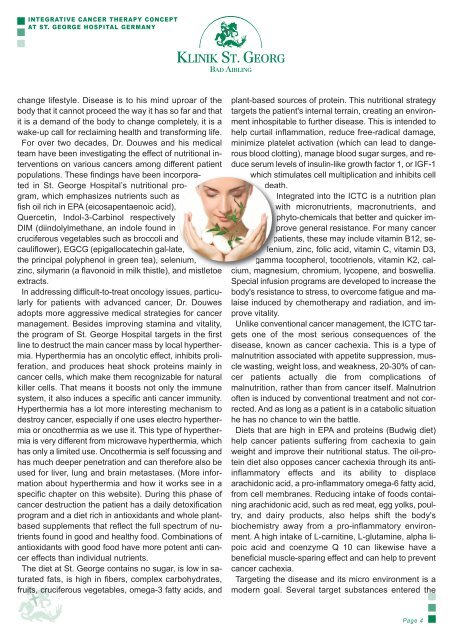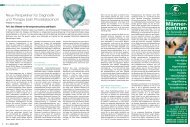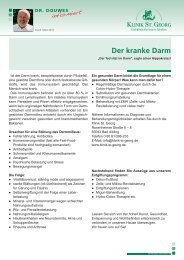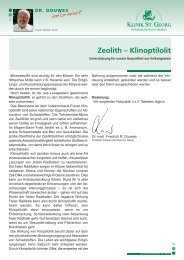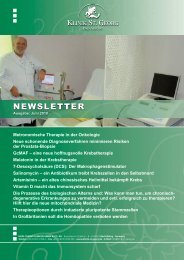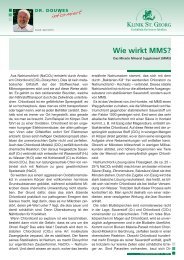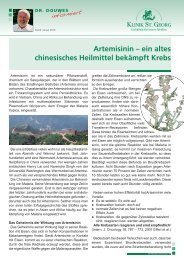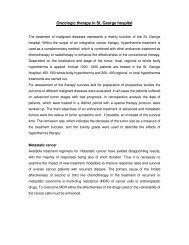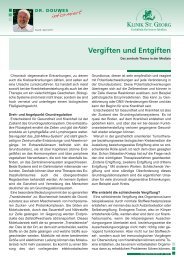InTegraTIve CanCer Therapy ConCepT aT ST ... - Klinik St. Georg
InTegraTIve CanCer Therapy ConCepT aT ST ... - Klinik St. Georg
InTegraTIve CanCer Therapy ConCepT aT ST ... - Klinik St. Georg
Create successful ePaper yourself
Turn your PDF publications into a flip-book with our unique Google optimized e-Paper software.
<strong>InTegr<strong>aT</strong>Ive</strong> <strong>CanCer</strong> <strong>Therapy</strong> <strong>ConCepT</strong><br />
<strong>aT</strong> <strong>ST</strong>. george hoSpITal germany<br />
change lifestyle. Disease is to his mind uproar of the<br />
body that it cannot proceed the way it has so far and that<br />
it is a demand of the body to change completely, it is a<br />
wake-up call for reclaiming health and transforming life.<br />
For over two decades, Dr. Douwes and his medical<br />
team have been investigating the effect of nutritional interventions<br />
on various cancers among different patient<br />
populations. These findings have been incorporated<br />
in <strong>St</strong>. <strong>Georg</strong>e Hospital’s nutritional program,<br />
which emphasizes nutrients such as<br />
fish oil rich in EPA (eicosapentaenoic acid),<br />
Quercetin, Indol-3-Carbinol respectively<br />
DIM (diindolylmethane, an indole found in<br />
cruciferous vegetables such as broccoli and<br />
cauliflower), EGCG (epigallocatechin gal-late,<br />
the principal polyphenol in green tea), selenium,<br />
zinc, silymarin (a flavonoid in milk thistle), and mistletoe<br />
extracts.<br />
In addressing difficult-to-treat oncology issues, particularly<br />
for patients with advanced cancer, Dr. Douwes<br />
adopts more aggressive medical strategies for cancer<br />
management. Besides improving stamina and vitality,<br />
the program of <strong>St</strong>. <strong>Georg</strong>e Hospital targets in the first<br />
line to destruct the main cancer mass by local hyperthermia.<br />
Hyperthermia has an oncolytic effect, inhibits proliferation,<br />
and produces heat shock proteins mainly in<br />
cancer cells, which make them recognizable for natural<br />
killer cells. That means it boosts not only the immune<br />
system, it also induces a specific anti cancer immunity.<br />
Hyperthermia has a lot more interesting mechanism to<br />
destroy cancer, especially if one uses electro hyperthermia<br />
or oncothermia as we use it. This type of hyperthermia<br />
is very different from microwave hyperthermia, which<br />
has only a limited use. Oncothermia is self focussing and<br />
has much deeper penetration and can therefore also be<br />
used for liver, lung and brain metastases. (More information<br />
about hyperthermia and how it works see in a<br />
specific chapter on this website). During this phase of<br />
cancer destruction the patient has a daily detoxification<br />
program and a diet rich in antioxidants and whole plantbased<br />
supplements that reflect the full spectrum of nutrients<br />
found in good and healthy food. Combinations of<br />
antioxidants with good food have more potent anti cancer<br />
effects than individual nutrients.<br />
The diet at <strong>St</strong>. <strong>Georg</strong>e contains no sugar, is low in saturated<br />
fats, is high in fibers, complex carbohydrates,<br />
fruits, cruciferous vegetables, omega-3 fatty acids, and<br />
plant-based sources of protein. This nutritional strategy<br />
targets the patient's internal terrain, creating an environment<br />
inhospitable to further disease. This is intended to<br />
help curtail inflammation, reduce free-radical damage,<br />
minimize platelet activation (which can lead to dangerous<br />
blood clotting), manage blood sugar surges, and reduce<br />
serum levels of insulin-like growth factor 1, or IGF-1<br />
which stimulates cell multiplication and inhibits cell<br />
death.<br />
Integrated into the ICTC is a nutrition plan<br />
with micronutrients, macronutrients, and<br />
phyto-chemicals that better and quicker improve<br />
general resistance. For many cancer<br />
patients, these may include vitamin B12, selenium,<br />
zinc, folic acid, vitamin C, vitamin D3,<br />
gamma tocopherol, tocotrienols, vitamin K2, calcium,<br />
magnesium, chromium, lycopene, and boswellia.<br />
Special infusion programs are developed to increase the<br />
body's resistance to stress, to overcome fatigue and malaise<br />
induced by chemotherapy and radiation, and improve<br />
vitality.<br />
Unlike conventional cancer management, the ICTC targets<br />
one of the most serious consequences of the<br />
disease, known as cancer cachexia. This is a type of<br />
malnutrition associated with appetite suppression, muscle<br />
wasting, weight loss, and weakness, 20-30% of cancer<br />
patients actually die from complications of<br />
malnutrition, rather than from cancer itself. Malnutrion<br />
often is induced by conventional treatment and not corrected.<br />
And as long as a patient is in a catabolic situation<br />
he has no chance to win the battle.<br />
Diets that are high in EPA and proteins (Budwig diet)<br />
help cancer patients suffering from cachexia to gain<br />
weight and improve their nutritional status. The oil-protein<br />
diet also opposes cancer cachexia through its antiinflammatory<br />
effects and its ability to displace<br />
arachidonic acid, a pro-inflammatory omega-6 fatty acid,<br />
from cell membranes. Reducing intake of foods containing<br />
arachidonic acid, such as red meat, egg yolks, poultry,<br />
and dairy products, also helps shift the body's<br />
biochemistry away from a pro-inflammatory environment.<br />
A high intake of L-carnitine, L-glutamine, alpha lipoic<br />
acid and coenzyme Q 10 can likewise have a<br />
beneficial muscle-sparing effect and can help to prevent<br />
cancer cachexia.<br />
Targeting the disease and its micro environment is a<br />
modern goal. Several target substances entered the<br />
Page 4


